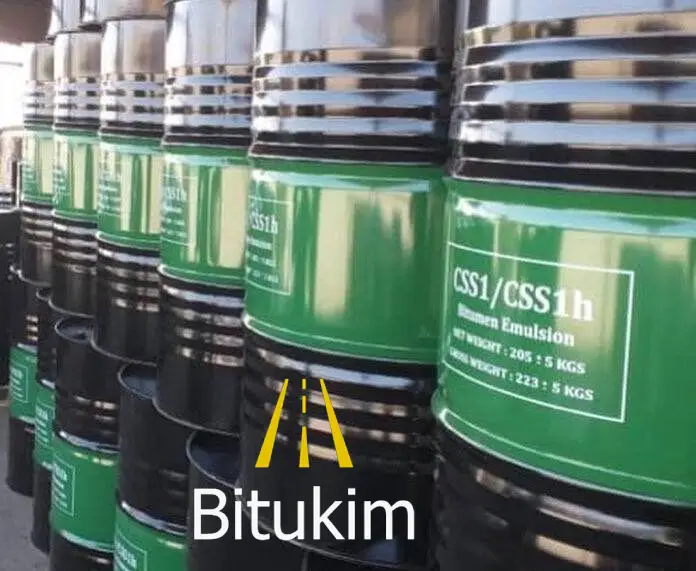
Description of Bitumen Emulsion CSS-1h
Bitumen Emulsion CSS-1h is formulated from a blend of bitumen, water, and an emulsifying agent, which enables the stable integration of bitumen with water. The cationic nature of CSS-1h, characterized by its positively charged particles, promotes strong adhesion to negatively charged aggregates, ensuring a robust bond with the road surface. Typically, CSS-1h exhibits moderate viscosity, which facilitates smooth application and effective coating of aggregates, though the viscosity may vary slightly depending on specific formulations.
The “h” designation signifies its slow-setting property, allowing extended workability for applications requiring additional time for the emulsion to break and the bitumen to cure. As a key component, bitumen—a viscous, petroleum-based binder—provides excellent adhesive qualities, securing road construction materials. Once cured, CSS-1h forms a durable layer resistant to water and weathering, significantly enhancing the lifespan and durability of road surfaces.
Application of Cationic Emulsion CSS-1h
Emulsion CSS-1 has many applications in industries but it’s usually used in Road construction. Emulsion CSS-1h is applied as a prime coat on the prepared base surface before laying subsequent layers of asphalt. and also, It serves as a bonding layer that improves the adhesion between the base surface and the overlying asphalt layers. This enhances the stability and durability of the road.
CSS-1h is commonly used as a tack coat in road construction. and It acts as a bonding agent that effectively joins different asphalt layers or binds asphalt to various road surfaces. This ensures that the different layers adhere together securely, preventing delamination and enhancing road integrity.
Emulsion CSS-1h is employed for pothole repair and patching on existing roads. Its slow-setting properties allow for effective adhesion and curing in potholes, providing a long-lasting solution to road surface damage.
Emulsion CSS-1h is used for crack sealing on road surfaces. It is applied to cracks in the road surface to prevent water infiltration, freeze-thaw damage, and further deterioration. This extends the life of the road and reduces the need for more extensive repairs.
Properties of Cationic Bitumen Emulsion CSS-1h
CSS-1h is a slow-setting cationic bitumen emulsion composed of bitumen, water, and an emulsifying agent, which ensures stable mixing and easy application. Its positively charged particles enhance adhesion to negatively charged aggregates, improving bonding strength in road construction.
With moderate viscosity and compatibility with various aggregates, CSS-1h is suitable for applications requiring extended work time. It is environmentally friendly, requires minimal heating, and offers strong weather resistance after curing. Its stable formulation allows for reliable storage and transport, and it can be applied using multiple methods such as spraying or brushing.
Advantage
- Lower Energy Consumption: CSS-1h emulsions are applied at lower temperatures compared to hot mix asphalt. This reduces energy consumption during production and application, making it more environmentally friendly and potentially cost-effective.
- Versatility: CSS-1h emulsions can be used in various road construction and maintenance applications, such as chip sealing, micro-surfacing, tack coating, and prime coating. They are compatible with a wide range of aggregates and surface conditions.
- Improved Workability: The emulsified form of bitumen in CSS-1h makes it easier to handle and apply. It allows for better coating of aggregates, resulting in improved adhesion and a smoother road surface.
- Repair Road: CSS-1h emulsions can be used to repair Roads and extend the life of existing asphalt surfaces, reducing the need for costly full-depth reconstruction.
Safety Tips of Bitumen Emulsion CSS-1h
When handling Bitumen Emulsion CSS-1h, it’s important to follow proper safety guidelines to ensure the well-being of workers and the integrity of the worksite. Always wear appropriate personal protective equipment (PPE), such as gloves, safety goggles, and protective clothing, to prevent skin and eye contact. Work in well-ventilated areas to avoid inhalation of any fumes, especially during application.
Avoid direct contact with hot surfaces or open flames, as bitumen, while emulsified, is still flammable when dry. In case of spills, contain and clean the emulsion promptly to prevent environmental contamination. Proper storage is also crucial—keep the emulsion in sealed containers away from extreme temperatures and direct sunlight to maintain product stability and reduce risks.
Packing of CSS-1h
The Cationic Bitumen Emulsion CSS-1h is usually packed in bulk, Steel Drum, and IBC Tank but The packing type depends on the quantity of the product and the specific requirements of the customer.
- 1MT IBC Tank
- 200 Kg New Steel Drum- Palletized
- Bulk in Tuck Tanker
Specification of Bitumen Emulsion CSS-1h
| Property | Min | Max | Test Method |
|---|---|---|---|
| Viscosity, Saybolt Furol at 25 °C, SFS | 20 | 100 | ASTM D244 |
| Storage stability test, 24-h, % | – | 1 | ASTM D6930 |
| Particle charge test | positive | positive | ASTM D244 |
| Sieve test, % | – | 0.1 | ASTM D6933 |
| Cement mixing test, % | – | 2.0 | ASTM D6935 |
| Residue, % | 57 | – | ASTM D244 |
| Penetration, 25°C (77°F), 100 g, 5 s | 40 | 90 | ASTM D5 |
| Ductility, 25°C (77°F), 5 cm/min, cm | 40 | – | ASTM D113 |
| Solubility in trichloroethylene, % | 97.5 | – | ASTM D2042 |

